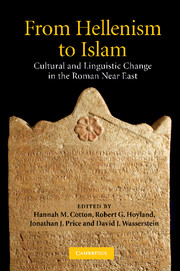Book contents
- Frontmatter
- Contents
- List of figures
- List of tables
- List of contributors
- Preface
- List of abbreviations
- Introduction: documentary evidence, social realities and the history of language
- Part I THE LANGUAGE OF POWER: LATIN IN THE ROMAN NEAR EAST
- Part II SOCIAL AND LEGAL INSTITUTIONS AS REFLECTED IN THE DOCUMENTARY EVIDENCE
- Part III THE EPIGRAPHIC LANGUAGE OF RELIGION
- Part IV LINGUISTIC METAMORPHOSES AND CONTINUITY OF CULTURES
- 10 On the margins of culture: the practice of transcription in the ancient world
- 11 Edessene Syriac inscriptions in late antique Syria
- 12 Samaritan writing and writings
- 13 The Jewish magical tradition from late antique Palestine to the Cairo Genizah
- Part V GREEK INTO ARABIC
- Index
10 - On the margins of culture: the practice of transcription in the ancient world
Published online by Cambridge University Press: 01 March 2010
- Frontmatter
- Contents
- List of figures
- List of tables
- List of contributors
- Preface
- List of abbreviations
- Introduction: documentary evidence, social realities and the history of language
- Part I THE LANGUAGE OF POWER: LATIN IN THE ROMAN NEAR EAST
- Part II SOCIAL AND LEGAL INSTITUTIONS AS REFLECTED IN THE DOCUMENTARY EVIDENCE
- Part III THE EPIGRAPHIC LANGUAGE OF RELIGION
- Part IV LINGUISTIC METAMORPHOSES AND CONTINUITY OF CULTURES
- 10 On the margins of culture: the practice of transcription in the ancient world
- 11 Edessene Syriac inscriptions in late antique Syria
- 12 Samaritan writing and writings
- 13 The Jewish magical tradition from late antique Palestine to the Cairo Genizah
- Part V GREEK INTO ARABIC
- Index
Summary
DYING LANGUAGES AND LINGUISTIC SEAMS
Dozens of languages were spoken in the ancient world during the period stretching from the Hellenistic to the Islamic conquests. There were far fewer writing systems than spoken languages, which means that not every language had a cognate script, and many died out before ever being written down. But for those languages with a tradition and formalised system of writing, the connection between language and script was strong. Long integral texts written in the script of another language are a medieval phenomenon; they were not produced as a mainstream cultural activity in antiquity. The concept of separating language from script was not entirely absent, but it is our thesis that a transcribed text invariably indicates marginality or liminality of some kind: a language or script which is dying, an individual on a cultural/linguistic seam, a peripheral medium such as magic, a scholastic exercise. These exceptional cases constitute the first part of the current investigation. In the second part, we shall examine the more complex instance of rabbinical traditions regarding the scripts and languages used in writing biblical books.
In antiquity, it seems, language and script were thought of generally as a unit, to the extent that reference to a particular system of ‘letters’ or ‘writing’ could signify the literary or even the spoken language itself. For example, when Herodotus relates (4.87) that Darius set up two stelae on the Bosporos, ἐνταμὼν γράμματα ἐς μὲν τὴν 'Aσσύρια, ἐς δὲ τὴν ‘Eλληνικά, he of course means not strictly two scripts but two languages, i.e. a bilingual inscription in Aramaic and Greek, each written in its cognate script.
- Type
- Chapter
- Information
- From Hellenism to IslamCultural and Linguistic Change in the Roman Near East, pp. 257 - 288Publisher: Cambridge University PressPrint publication year: 2009
- 2
- Cited by



